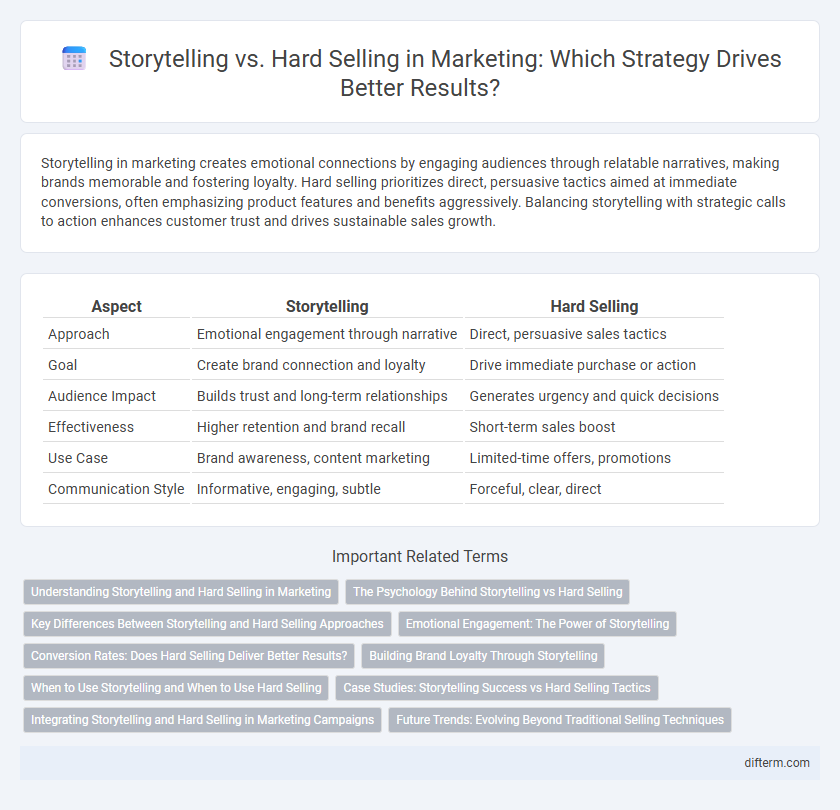Storytelling in marketing creates emotional connections by engaging audiences through relatable narratives, making brands memorable and fostering loyalty. Hard selling prioritizes direct, persuasive tactics aimed at immediate conversions, often emphasizing product features and benefits aggressively. Balancing storytelling with strategic calls to action enhances customer trust and drives sustainable sales growth.
Table of Comparison
| Aspect | Storytelling | Hard Selling |
|---|---|---|
| Approach | Emotional engagement through narrative | Direct, persuasive sales tactics |
| Goal | Create brand connection and loyalty | Drive immediate purchase or action |
| Audience Impact | Builds trust and long-term relationships | Generates urgency and quick decisions |
| Effectiveness | Higher retention and brand recall | Short-term sales boost |
| Use Case | Brand awareness, content marketing | Limited-time offers, promotions |
| Communication Style | Informative, engaging, subtle | Forceful, clear, direct |
Understanding Storytelling and Hard Selling in Marketing
Understanding storytelling in marketing involves crafting engaging narratives that emotionally connect with consumers, building brand loyalty and trust over time. Hard selling emphasizes direct, persuasive tactics aimed at immediate sales, often focusing on product features and urgency. Balancing storytelling with hard selling allows marketers to create compelling campaigns that both resonate emotionally and drive quick conversions.
The Psychology Behind Storytelling vs Hard Selling
Storytelling leverages emotional engagement and cognitive resonance, tapping into the brain's natural affinity for narratives to build trust and brand loyalty. Hard selling triggers a direct response by appealing to urgency and immediate needs, often activating the fight-or-flight mechanism associated with high-pressure decisions. Understanding these psychological drivers allows marketers to tailor strategies that either cultivate deep consumer connection or prompt quick transactional actions.
Key Differences Between Storytelling and Hard Selling Approaches
Storytelling in marketing leverages emotional connection and narrative to build brand loyalty, fostering long-term customer engagement through relatable experiences. Hard selling centers on direct, persuasive tactics aimed at immediate purchase decisions, often emphasizing product features and urgency. The key difference lies in storytelling's subtle influence versus hard selling's explicit call-to-action, impacting consumer perception and retention differently.
Emotional Engagement: The Power of Storytelling
Storytelling creates deep emotional engagement by connecting consumers to brands through relatable narratives and authentic experiences. Human brains are wired to respond to stories, activating empathy and memory centers that boost brand recall and loyalty. Hard selling tactics often trigger resistance, whereas storytelling fosters trust and long-term customer relationships by appealing to emotions rather than just logic.
Conversion Rates: Does Hard Selling Deliver Better Results?
Hard selling often yields immediate conversion spikes by creating urgency and clear calls to action, making it effective for time-sensitive campaigns. However, storytelling fosters deeper emotional connections, enhancing trust and long-term customer loyalty, which can lead to higher lifetime customer value and sustained conversions. Data from HubSpot reveals that brands utilizing storytelling see conversion rate improvements of up to 30% compared to traditional hard selling tactics.
Building Brand Loyalty Through Storytelling
Storytelling creates emotional connections that foster long-term brand loyalty by engaging customers on a personal level. Unlike hard selling, which emphasizes immediate transactions, storytelling builds trust and authenticity, encouraging repeat purchases and advocacy. Brands leveraging compelling narratives see increased customer retention and stronger market differentiation.
When to Use Storytelling and When to Use Hard Selling
Storytelling is most effective when brands aim to build emotional connections and long-term loyalty by sharing relatable experiences and values. Hard selling works best in time-sensitive situations or when targeting customers in the decision-making phase who require straightforward, clear calls to action. Marketers should leverage storytelling in content marketing campaigns and use hard selling techniques during promotions, flash sales, or direct response advertising.
Case Studies: Storytelling Success vs Hard Selling Tactics
Case studies reveal that storytelling drives higher customer engagement and brand loyalty compared to hard selling tactics, which often result in short-term conversions but lower trust. Brands like Nike and Apple leverage storytelling to create emotional connections, leading to sustained growth and customer retention. In contrast, hard selling approaches may boost immediate sales but typically lack the depth to foster long-term brand advocacy.
Integrating Storytelling and Hard Selling in Marketing Campaigns
Integrating storytelling and hard selling in marketing campaigns enhances audience engagement by combining emotional connection with clear calls to action. Storytelling builds brand identity and trust, while hard selling drives immediate conversions through persuasive messaging. Balancing these elements maximizes customer retention and boosts overall campaign effectiveness.
Future Trends: Evolving Beyond Traditional Selling Techniques
Future marketing trends emphasize storytelling's power to build emotional connections and brand loyalty, contrasting with the declining effectiveness of hard selling methods. Advanced data analytics and AI-driven personalization enable brands to craft immersive, narrative-driven campaigns that resonate deeply with target audiences. Integrating experiential content with interactive technologies will increasingly define marketing strategies, shifting the focus from aggressive selling to engaging, value-driven customer experiences.
Storytelling vs hard selling Infographic

 difterm.com
difterm.com